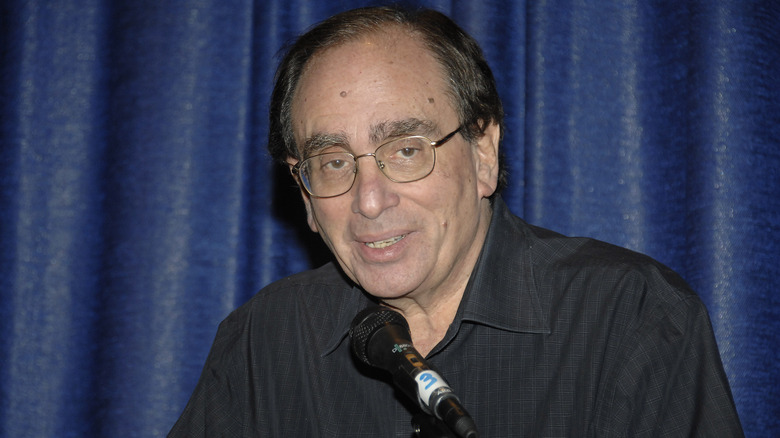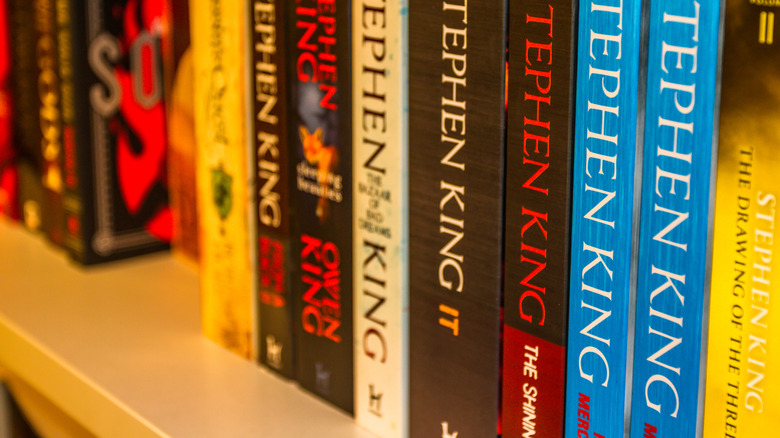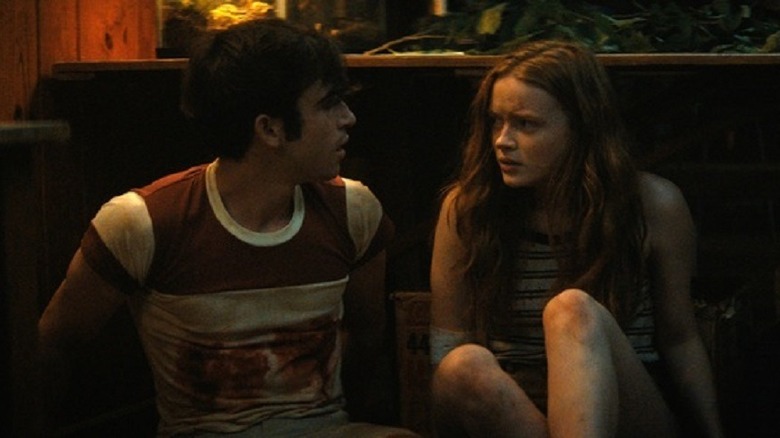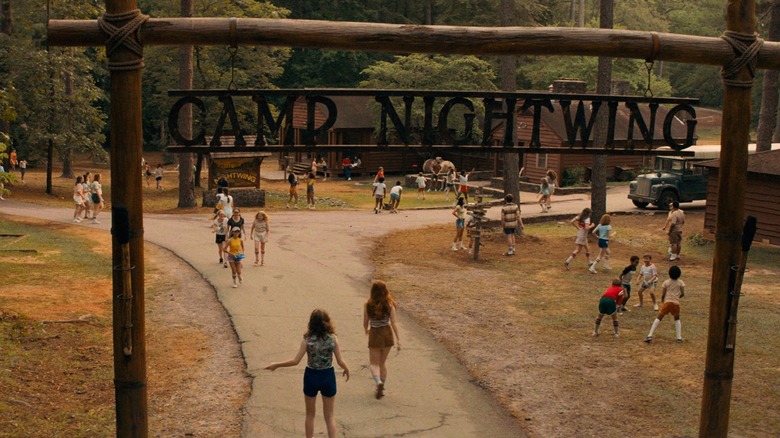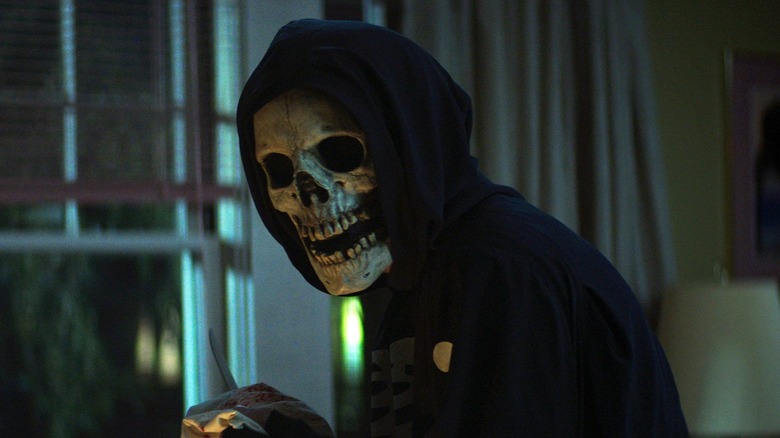Small Details You Missed In The Fear Street Trilogy
This content was paid for by Netflix and created by Looper.
The new "Fear Street" trilogy takes audiences on a thrilling trip through multiple generations of mayhem in Shadyside, Ohio, a town with a very spooky past. Not only will you see how the place came to have such a bloody history. You'll also see how one group of intrepid teens might just be able to put an end to all the madness.
The action begins in 1994, as yet another slaughter spree grips the troubled town and a prank-gone-wrong accidentally reveals one of Shadyside's darkest secrets. See, although the Shadysiders have faced a number of serial killers over the years, the young heroes of "Fear Street" discover that the local myth that a witch cursed their homestead in the colonial times isn't exactly true.
As the teens square off against some of the town's most notorious killers, many of whom have been dead for decades, they turn to a survivor of a brutal 1978 massacre for help, before looking back to 1666 to uncover the shocking identity of the family responsible for all of Shadyside's troubles.
In addition to weaving an elaborate, chilling portrait of Shadyside's macabre history, the "Fear Street" trilogy is also filled with fun Easter eggs and other small details that only a keen eye will catch. Here's a look at what you might have missed when you first watched this spectacular summer film series. Beware spoilers!
All the R.L. Stine covers
For '90s kids who grew up with a fondness for scary stories, the "Fear Street" novels were essential reading. "Goosebumps" creator R.L. Stine became a pop culture phenomenon thanks largely to his tales about the terrors of Shadyside, and the films honor his legacy in a big way. Like the "Fear Street" books, the films center on the tragedy-stricken town and the centuries-old feud between the Fier family and the Goodes. And even though the films craft their own narrative about the town's sordid history, they contain tons of nods to R.L. Stine's original stories, too.
In fact, the very first scene in the movies winks at the books. Heather (Maya Hawke) opens the first film reading the logline to "The Wrong Number," the fifth "Fear Street" book, out loud, telling her customer that it's a "fantastic choice." Of course, the customer isn't too impressed, calling the book "lowbrow horror." There's another Easter egg hidden in there, too. Although the title of the book and its cover art match that of Stine's 1990 novel, the author's name has been changed to Robert Lawrence, which is the R.L. in R.L. Stine.
Shortly thereafter, as Heather closes shop for the night, we see a larger display of "Fear Street" books, including "The Surprise Party," "The First Evil," and "The Sleepwalker," all of which bear Robert Lawrence's name. In the real world, all of these books were released before 1994, when the movie takes place. Appropriately, Heather uses a copy of "The First Evil" to stop the Skull Mask killer from stabbing her — at least, the first time he tries.
The Robert Lawrence books save the day in a much bigger way in the third film, when the action returns to the Shadyside Mall after a couple of trips back in time. After Deena (Kiana Madeira) becomes the target of the Shadyside killers, she tapes multiple copies of the "Fear Street" books from Heather's store onto her chest, creating a piece of makeshift armor. Not only do the films give life to Stine's chilling "Fear Street" tales, but in this way some of the most memorable books in the series also become a vital part of the action.
Other literary and horror legends
R.L. Stine isn't the only master of horror who is honored throughout the "Fear Street" films. Stephen King, who's also no stranger to live-action adaptations of his work, is another horror legend who gets a lot of love in the trilogy. For starters, King's books can be seen on display throughout the bookstore sequences in the first and third films' 1994 segments. Most noticeably, his novel "Insomnia," which would've been a very new release at the time, is prominently featured on a poster and on the front shelves. Eagle-eyed viewers might also notice other King titles in the store, including "Skeleton Crew" and "The Talisman."
King also gets several call-outs in the second film, which is set in 1978. A shared love of King novels brings Ziggy Berman ("Stranger Things" star Sadie Sink) and Nick Goode (Ted Sutherland) closer together at Camp Nightwing. As Ziggy plots revenge against the bullies who are tormenting her, Nick notes that her red paint plan is a nod to the highly influential King adaptation "Carrie." Nick also says that his favorite novel is King's "Salem's Lot." In addition, Nick is eager to check out King's newest release, which he's heard good things about. King historians will know that by July of 1978, King had already released "The Shining," while his fourth book, "The Stand," was just a few months away from hitting shelves. Meanwhile, the same blood-soaking trick Ziggy borrowed from "Carrie" comes into play when Ziggy tries to douse Nick with Deena's blood in order to turn the zombie killers' attention on him, and away from her young new pals.
In addition to King, another novelist who gets a namecheck in the story is Judy Blume, who the 1978 versions of Ziggy and Nick plan to discuss at a book club. Finally, if you look closely in the bookstore scenes in 1994, you can see some other notable bestsellers on display, including the horror novels of Dean Koontz, several "Nancy Drew" mysteries, and books by Robert Ludlum, Joseph Heller, Robert Jordan, Jackie Collins, John Grisham, and Tom Clancy, among others.
A horror pastiche
Horror fans are bound to notice the clever ways in which the "Fear Street" films pay homage to some of the most standout movies of the genre. The 1994 segment, for example, is partly inspired by Wes Craven's seminal teen slasher film "Scream," and it shows. Consider the creepy call that Heather gets before she's stalked around the store by the Skull Mask killer, which is pretty similar to that iconic opening scene with Drew Barrymore. Even the killer's costume bears a striking resemblance to the Ghostface getup that terrorized the teens of Woodsboro, California. Similarly, when Heather finally unmasks the person who's murdering her, it's a familiar face, much like the surprise audiences got when they found out who was responsible for stalking our heroes in "Scream."
"Part 2," which takes place in 1978, also calls back to some of the best slasher pics of its era. Via Indie Wire, writer-director Leigh Janiak has pointed to time-honored favorites such as "Halloween," "Friday the 13th," and "Nightmare on Elm Street” as providing some cinematic inspiration for the second leg of the story, and you won't have to look long to spot the winks this segment gives to those tales. In fact, the entire ambiance of Camp Nightwing is instantly reminiscent of Camp Crystal Lake, a getaway that also featured counselors who were too caught up in their own drama to protect themselves from the maniac picking them all off one by one.
Plus, thanks to the multitude of killers that return from the past after the Berman sisters attempt to reunite Sarah Fier's hand with her body, we get to see a full-on array of different slasher stylings, including young Billy Barker, whose childish mask might just remind you of a young Michael Myers, and the deviant milkman Harry Rooker, who wields a knife just like the grown version of the "Halloween" murderer. Overall, the look and feel of "Part 2" features attack scenes aplenty that transport audiences back to the foundational era for slasher fare, from the cuts of the camera to the cuts of the blades that are taking everybody down.
As for "Part 3," which is set in 1666, the film borrows a bit from an unlikely source — Terrence Malick's 2005 film "The New World." So how did the tale of a love triangle between Pocahontas, John Smith, and John Rolfe influence Janiak? Well, as she explained, she was particularly inspired by the film's depiction of "the beautiful world made rotten."
A case of history repeating
Another aspect of the "Fear Street" movies you might notice better the second time around is just how many parallels exist between the films' various timelines. In particular, several moments in the 1666 storyline directly mirror what happened in the 1994 installment, proving just how tightly connected the Shadyside's modern-day nightmares are to its haunted past.
For example, the mothers of Samantha and her vintage double Hannah Miller (both played by Olivia Welch) offer similar words of condemnation for their girlfriends, Deena and Sarah, after the moms begin to suspect that the young ladies are romantically entangled. In both eras, the mothers accuse their daughter's lovers of trying to "ruin" their children. You might also notice that both Sheriff Goode and his colonial counterpart Solomon try to convince Deena and Sarah that they're trustworthy, even though they both hide a family secret that could doom these young women.
There's some clever continuity in the nicknames that the characters give to their mind-altering drugs, too. In the 1994 story, Kate (Julia Rehwald) cheekily refers to the pills she sells as blueberries. In 1666, kids try to get hallucinatory berries from the mysterious widow. Meanwhile, both Deena and Sarah's younger brothers criticize the girls for sleeping in too late. The back-checking scenes between Kate and her throwback version are also creepily similar.
Perhaps the most heartbreaking instance of history repeating itself happens with two different characters from the 1994 timeline. After Heather unmasks the Skull Mask killer and realizes that it's her close friend Ryan (David W. Thompson), she begs him to stop, saying "it's me." Sadly, she can't get through to him. Later on, after Sam has been possessed by the devil and attacks Deena, Deena makes a similar plea — this time, however, it works.
All the death threats
Speaking of phrases that span generations, another eerie aspect of these movies that resonates upon a second viewing is how many times the characters foreshadow certain fates by threatening to kill one another. Even when the characters are joking, these deaths often come to pass anyway.
For example, after Deena gives Sam her sweater, she teases, "If you get blood on it, I'll kill you." And, indeed, she does end up killing Sam, even if it's just an effort to stop Sam's heart long enough to break the spell. When two of the camp counselors from opposing towns hook up in the second "Fear Street" movie, the fella warns the girl that he'll kill her if she tells anyone. She's slaughtered by the Nightwing killer just seconds later. It's probably no coincidence that this is the same guy who, during his color war speech, jokes that it is time to "murder those Shadyside witches," just before Nick curses the same folks to meet brutal ends before the night is over.
On the other hand, sometimes it's the characters who mention murder who end up on the chopping block. Kate basically threatens everyone in Sunnyvale, but she's the one who gets thrown into the slicer at the grocery store melee. Poor Cindy Berman (Emily Rudd) jokes that she might have to murder her boyfriend Tommy Slater (McCabe Slye), not knowing that he has secretly become Shadyside's newest psycho killer. Whoops.
There's also one instance where one character correctly predicts another's survival. When Ziggy turns to Nurse Mary (Jordana Spiro) for a salve to help with her burn, Mary jokes that Ziggy will survive, which is much more prescient than she realizes.
The most devilish clues
It's just not just these errant death threats that serve as warnings for what's to come. Throughout the "Fear Street" films, other small pieces of dialogue offer clues as to what the future holds. For example, Simon tells Deena that she might have "a little witch" in her, which she ultimately does after she connects with Sarah Fier's mind in the past. In addition, Kate prophetically calls her a "lady killer."
Looking back, you'll also notice that there are a lot of clues that the Goode boys are really evil. For example, the Sunnyvale mascot is the devil, which might have slipped your attention before you knew what the founding family did to make the town such a nice place to live. Certain visual clues pop up in the 1978 storyline as well, like Nick literally having blood on his hands, and a snake crawling into his lap like a loving pet.
Perhaps the biggest clue about Sheriff Goode's true nature comes in his brief interaction with Martin (Darrell Britt-Gibson), who he has arrested for vandalism. In the scene, Sheriff Goode admits that the cans of spray paint are his. It seems like a joke at first, but once you realize that they really are Goode's, it becomes clear that the Sheriff himself is tagging Shadyside with the poem about the witch, ensuring that no one will forget the story that kept his family off of the public's radar for so many centuries.
